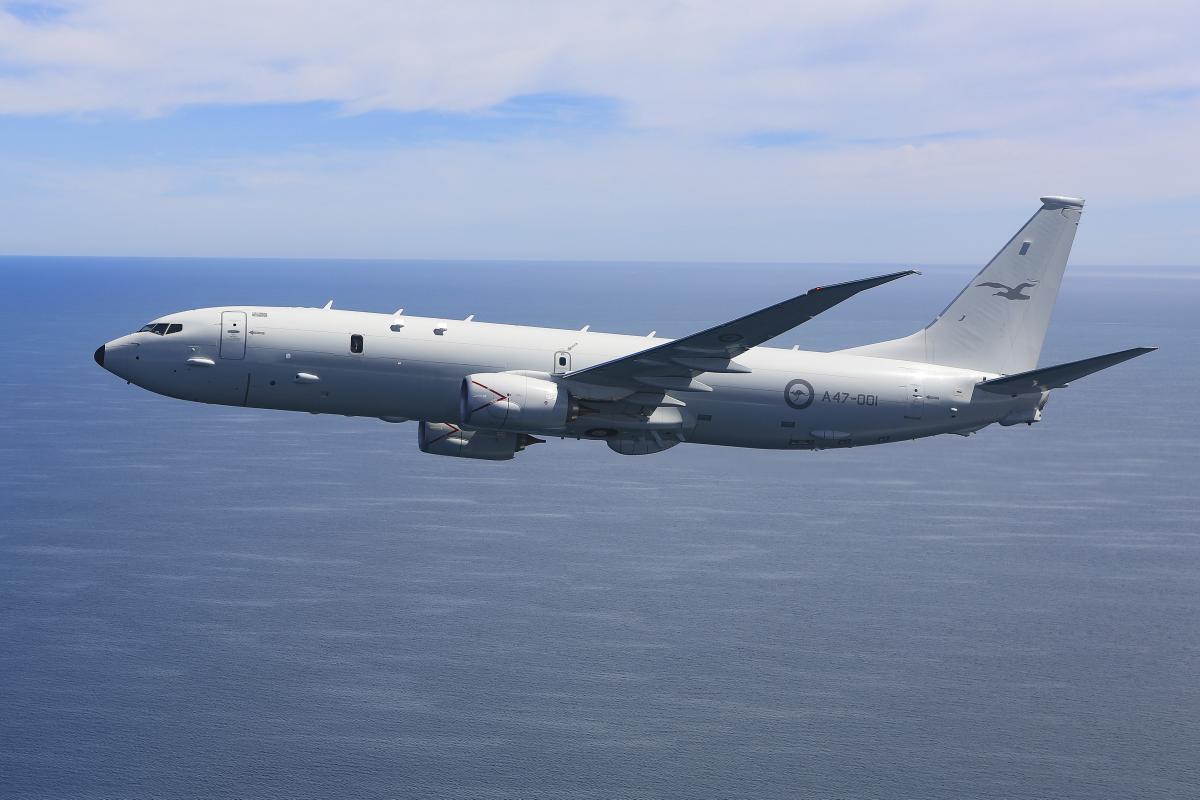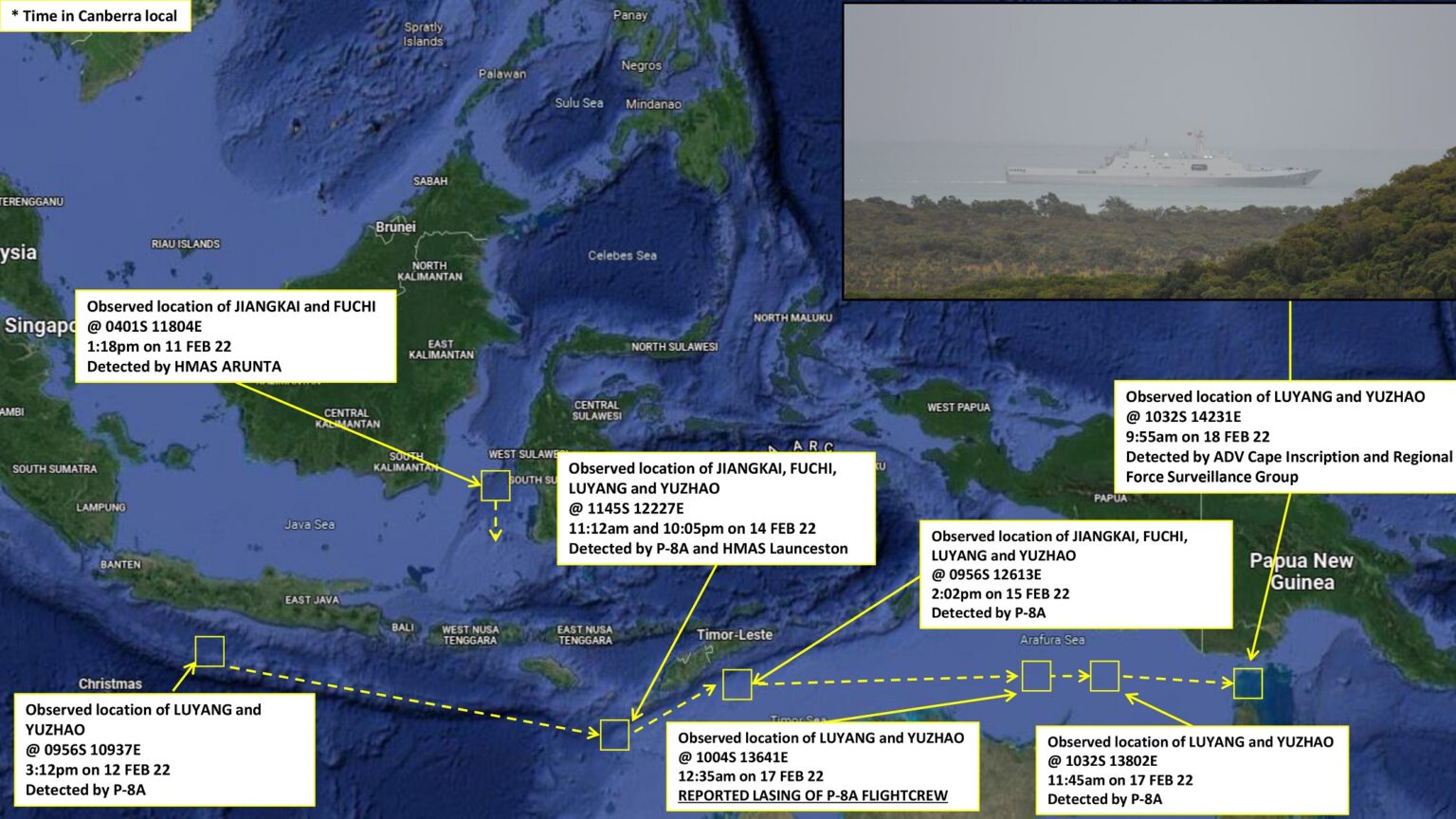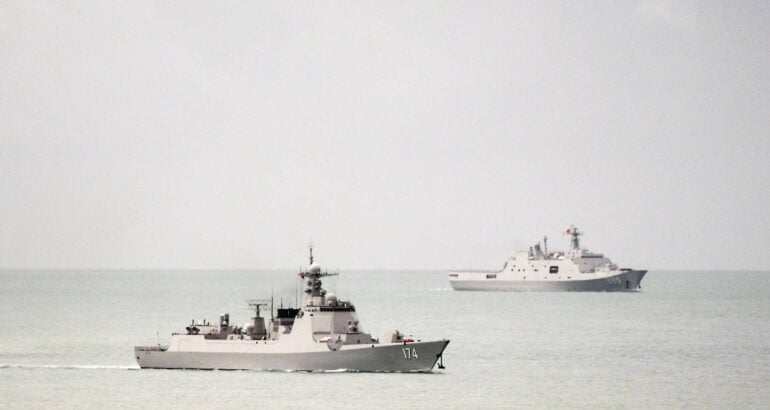
This post has been updated with an additional statement from the Australian government.
The Chinese military has denied that a People’s Liberation Army Navy warship used a laser last week to harass an Australian military aircraft, while Australian officials call for an investigation.
While China has yet to issue an official response directly to Australia on the incident, Senior Col. Tan Kifei, spokesperson for China’s Ministry of National Defense, told reporters on Monday that “on February 17, the Australian P-8 anti-submarine patrol aircraft arrived in the airspace surrounding our ship formation, and the nearest distance to our ship was only 4 kilometers. During the entire encounter with the Australian military aircraft, the Chinese warships always maintained safe, standardized and professional operations, in line with relevant international law and practice”.
Tan also showed photos of the Australian P-8 and purportedly a sonobuoy placed in the waters close to the PLAN ships.
“From the photos taken by our ship, it can be seen that the Australian aircraft is very close to our ship, and sonar buoys are also placed around our ship. Such malicious and provocative actions can easily lead to misunderstandings and misjudgements, posing a threat to the safety of ships, aircraft and personnel of both sides,” Tan said.
Tan accused Canberra of spreading false information and made false accusations. “We express our firm opposition to the above-mentioned actions by the Australian side. We demand that the Australian side immediately stop such provocative and dangerous actions, and stop making groundless accusations and smears against China, so as not to affect the overall relationship between the two countries and the two militaries,” he said.

Australia’s Defence Ministry on Saturday said a Royal Australian Air Force P-8 Poseidon had been illuminated by a laser from a PLAN ship on Thursday while flying over Australia’s northern Economic Exclusion Zone. The statement did not identify the specific warship, but said it was one of two PLAN ships sailing east through the Arafura Sea to the Coral Sea.
“We strongly condemn unprofessional and unsafe military conduct. These actions could have endangered the safety and lives of the Australian Defence Force personnel. Such actions are not in keeping with the standards we expect of professional militaries,” reads the statement.
Along with the statement, the Australian Department of Defence issued images of the PLAN ships in question and a graphic showing the movements of the two ships, along with two additional PLAN ships, identifying the units only by class. The two ships involved in the incident were identified as a Luyang-class destroyer and a Yuzhao-class amphibious transport dock, with the pennant numbers of the ships identifying them as destroyer CNS Hefei (174) and amphibious transport dock CNS Jinggang Shan (999).
It can be seen from the photos that the P-8A is very close to the Chinese warships, and P-8A even released sonobuoys nearby. Such provocative actions can easily lead to misunderstandings & misjudgments, posing a threat to the safety of ships, aircraft and personnel of both sides. pic.twitter.com/8Dzjv0osj2
— SCS Probing Initiative (@SCS_PI) February 21, 2022
The graphic showed that Royal Australian Navy (RAN) frigate HMAS Arunta (FFH 151) observed a Jiangkai-class frigate and a Fuchi-class replenishment ship off South Sulawesi on Feb. 11, while Hefei and Jinggang Shan had been detected south of Java on Feb. 12. Two days later, the four PLAN ships were observed sailing together southwest of Timor-Leste by patrol boat HMAS Launceston (ACPB 94), with the four ships observed sailing in the Timor Sea by a P-8. The Jiangkai-class frigate and the Fuchi-class replenishment ship appeared to have split away from Hefei and Jinggang Shan during the time of the incident on Thursday and the Australian Defence Ministry made no mention of their subsequent locations. Hefei and Jinggang Shan crossed the Torres Strait into the Coral Sea on Friday while patrol boat ADV Cape Inscription (320) and the Australian Army’s Regional Force Surveillance Group observed their movements.
Australia’s Ministry of Defence issued an additional statement on Tuesday in which it
stated that the use of sonobuoys for maritime surveillance was common practice and that the
sonobuoys had not been dropped prior to the lasing incident but only after it and these had
been dropped a significant distance ahead of the PLAN ship and that the P-8 was acting
within international law at all times.
It also stated that at the time of the lasing incident the P-8 was approximately 7.7
kilometers from the PLAN vessel and was flying at an altitude of 457m and that the closest
the P-8 flew to the PLAN vessel was approximately 4 kilometers adding that this was a
standard flight profile for RAAF maritime patrol aircraft for a visual investigation of a
surface vessel.
Australia expects all foreign vessels entering our maritime zones to abide by
international law, particularly the UNCLOS said the statement and added that Australia
supports and respects the rights of all states to exercise lawful freedom of navigation and
overflight in international waters and airspace. Australia does not engage in the spread of
misinformation or disinformation concluded the statement.
Both Australian Prime Minister Scott Morrison and Defence Minister Peter Dutton have made statements over the weekend and today in various media outlets condemning the incident and calling for an explanation.
In a press conference on Monday in Relbia, Tasmania, Morrison said the incident was unacceptable and that Australia has demanded an investigation.
“We expect China to provide some answers on those matters and we are going through those appropriate channels to achieve that. And we expect, and not just Australia, all countries in the region demand an answer to this because it’s an Australian surveillance aircraft this time. Who’s next? And so it’s very important that China explain themselves for this act of recklessness in our exclusive economic zone. They had every right to be there and traveling through those waters. Just as Australian vessels has every right to be up through the South China Sea, as well as the British and the Americans and the Japanese and the French and the Germans Canadians and everyone else sails through there. But it’s not okay to be doing what occurred there and we expect a full explanation,” he said.

In an interview with the Australian ABC News on Monday, Defence Minister Peter Dutton said Australia had not yet received a formal response from China that he would write to his counterpart today, adding that it was a concerning act.
“It cannot only disrupt some of the radar systems within the P8 surveillance plane, but it can blind the RAAF crew. This is a military grade laser system. It’s a deliberate act and it’s an unwelcome one and it’s an unprofessional act, an unsafe act, and that’s why we’ve called it out and we hope that by calling it out there’s a greater deterrence that it won’t happen in the future,” he said, adding that the two PLAN ships were in Australia’s EEZ and Australia was well within its rights to conduct surveillance on the ships.
In other developments, ALPACI, or France Pacific Command, issued a tweet today showing French Navy frigate FS Vendémiaire (F734) conducting operations in the South China Sea while a PLAN Jiangkai-class frigate watched.
Vendémiaire is on a regional deployment and on Saturday was replenished by U.S. replenishment ship USNS Guadalupe (T-AO-200). It will eventually head to Japan to take part in the United Nations’ monitoring of sanctions against North Korea.





